Have you ever taken a road trip that left you in awe of the diverse landscapes around you? Well, let me tell you about one of the most breathtaking journeys you can take in the United States – the Blue Ridge Parkway. Trust me, this scenic drive through the heart of the Appalachian Mountains is an experience you won’t want to miss.
Picture this: miles and miles of winding roads, surrounded by verdant forests, cascading waterfalls, and majestic mountain peaks. The Blue Ridge Parkway offers a visual treat at every turn. Whether you’re a nature enthusiast, a photography aficionado, or simply someone who appreciates the beauty of the great outdoors, this drive is perfect for you. And the best part is, there’s no rush. Take your time and soak in the stunning landscapes that unfold before you. In my upcoming article, I’ll share more about the must-see spots along the Blue Ridge Parkway and the hidden gems waiting to be discovered. So buckle up and get ready for a journey of a lifetime.
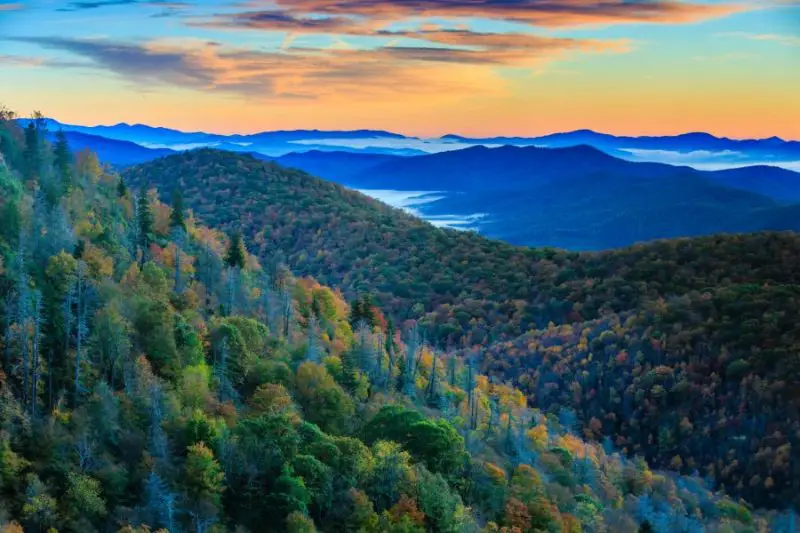
Overview of the Blue Ridge Parkway
The Blue Ridge Parkway is a 469-mile scenic road that winds through the stunning landscapes of the Blue Ridge Mountains in the United States. Stretching from Virginia to North Carolina, this picturesque drive offers breathtaking views, diverse flora and fauna, and a rich cultural and historical heritage. It is often referred to as “America’s Favorite Drive” and attracts millions of visitors each year.
Introduction to the Blue Ridge Parkway
As someone who has had the pleasure of exploring the Blue Ridge Parkway, I can confidently say that it is a true gem in the United States’ national park system. This iconic road showcases the natural beauty and charm of the Blue Ridge Mountains, and offers visitors the opportunity to immerse themselves in its stunning landscapes, rich history, and vibrant culture.
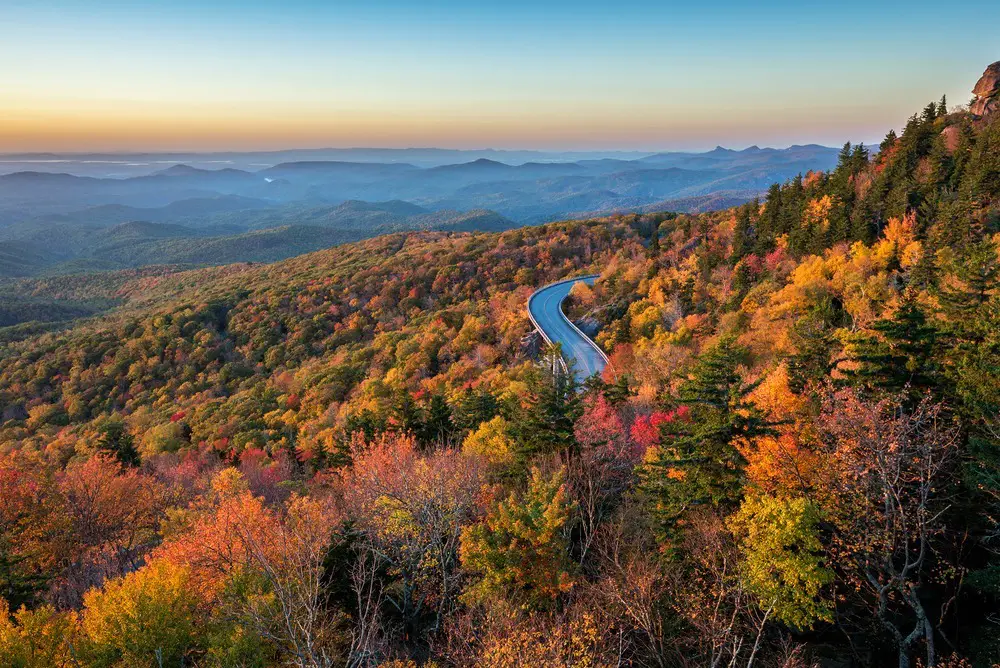
History and significance of the Blue Ridge Parkway
The construction of the Blue Ridge Parkway began in 1935 as a way to provide jobs during the Great Depression. It was also envisioned as a way to connect the Shenandoah National Park in Virginia with the Great Smoky Mountains National Park in North Carolina. The parkway was officially completed in 1987, after decades of planning and construction.
Today, the Blue Ridge Parkway stands as a testament to the preservation of natural beauty and the importance of providing accessible recreational opportunities for all. It is managed by the National Park Service and is one of the most visited units in the park system.
Length and route of the Blue Ridge Parkway
The Blue Ridge Parkway spans 469 miles, running through the Appalachian Mountains from the southern end of Shenandoah National Park in Virginia to the entrance of the Great Smoky Mountains National Park in North Carolina. Along the way, it passes through numerous counties and communities, providing visitors with a unique glimpse into the diverse landscapes and cultures of the region.
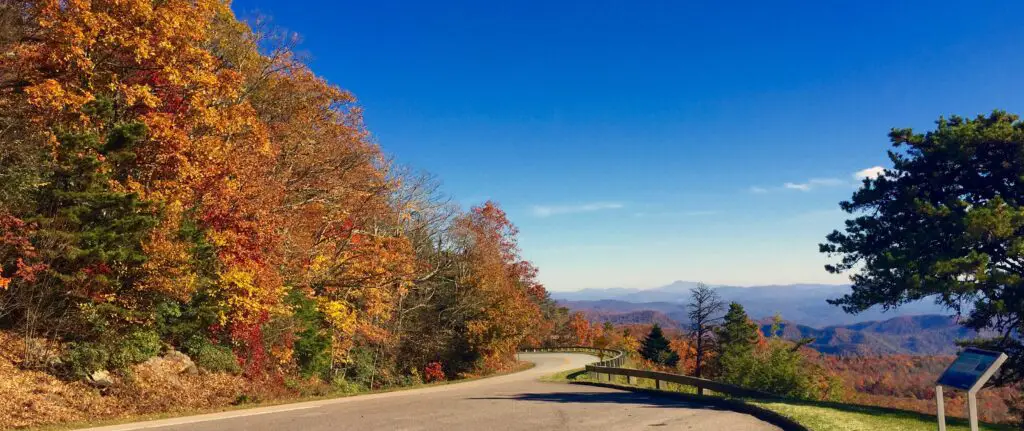
Beauty of the Blue Ridge Mountains
Overview of the Blue Ridge Mountains
The Blue Ridge Mountains are a part of the larger Appalachian Mountain range and are known for their stunning beauty and diversity. Named for the blue haze that often surrounds them, these mountains are a sight to behold in any season. From the rolling hills and lush valleys to the towering peaks and cascading waterfalls, there is no shortage of natural wonders in this region.
Geography and geology of the Blue Ridge Mountains
The Blue Ridge Mountains are characterized by their gentle slopes, rounded peaks, and narrow ridges. They are predominantly made up of ancient, erosion-resistant rocks such as granite and gneiss. The region is also known for its unique combination of climate, elevation, and rainfall, which contribute to the incredible biodiversity found here.
Flora and fauna of the Blue Ridge Mountains
The Blue Ridge Mountains are home to a rich variety of plant and animal species. The diverse forests of the region harbor a wide range of trees, including oak, hickory, and maple, as well as rare and endangered species such as the Carolina northern flying squirrel and the Appalachian quillwort. Wildlife enthusiasts can also spot black bears, white-tailed deer, and a myriad of bird species like the northern cardinal and wood thrush.
Scenic Drives on the Blue Ridge Parkway
Scenic routes and attractions along the Blue Ridge Parkway
The Blue Ridge Parkway offers an array of scenic drives and attractions that cater to every interest and preference. Some of the must-visit spots along the parkway include:
- Mabry Mill: This iconic mill is a favorite among visitors, offering a glimpse into the region’s agricultural history.
- Linville Gorge: Known as the “Grand Canyon of the East,” Linville Gorge is a breathtakingly beautiful area with rugged cliffs and stunning vistas.
- Linn Cove Viaduct: This engineering marvel is a highlight of the parkway, offering panoramic views and the feeling of driving through the treetops.
Driving tips and safety guidelines on the Blue Ridge Parkway
When embarking on a scenic drive along the Blue Ridge Parkway, it’s important to keep a few things in mind for a safe and enjoyable experience:
- Observe the speed limit: The speed limit on the parkway is 45 mph, and it is enforced to ensure the safety of all visitors.
- Be mindful of wildlife: The parkway is home to a wide array of wildlife, so be cautious and maintain a safe distance if you encounter any animals.
- Stay on designated trails and overlooks: To protect the delicate ecosystems and ensure your safety, it’s important to stick to designated areas.
Best time to visit for optimal scenic beauty
The Blue Ridge Parkway showcases awe-inspiring beauty throughout the year, but each season offers a unique experience. Here’s a breakdown of what to expect:
- Spring: Spring brings an explosion of color as wildflowers bloom and the landscape comes alive with vibrant greens. It is a perfect time for hiking and witnessing the rebirth of nature.
- Summer: Summer is an ideal time to experience pleasant weather and explore the many recreational opportunities along the parkway, such as camping, fishing, and picnicking.
- Fall: The Blue Ridge Parkway is famous for its stunning fall foliage. The forested mountains transform into a vibrant tapestry of reds, oranges, and yellows, drawing visitors from all over the world.
- Winter: Despite the cold temperatures, winter can be a magical time to visit. The snow-covered landscapes offer a serene and peaceful atmosphere, and some areas of the parkway may even be accessible for winter sports like cross-country skiing and snowshoeing.
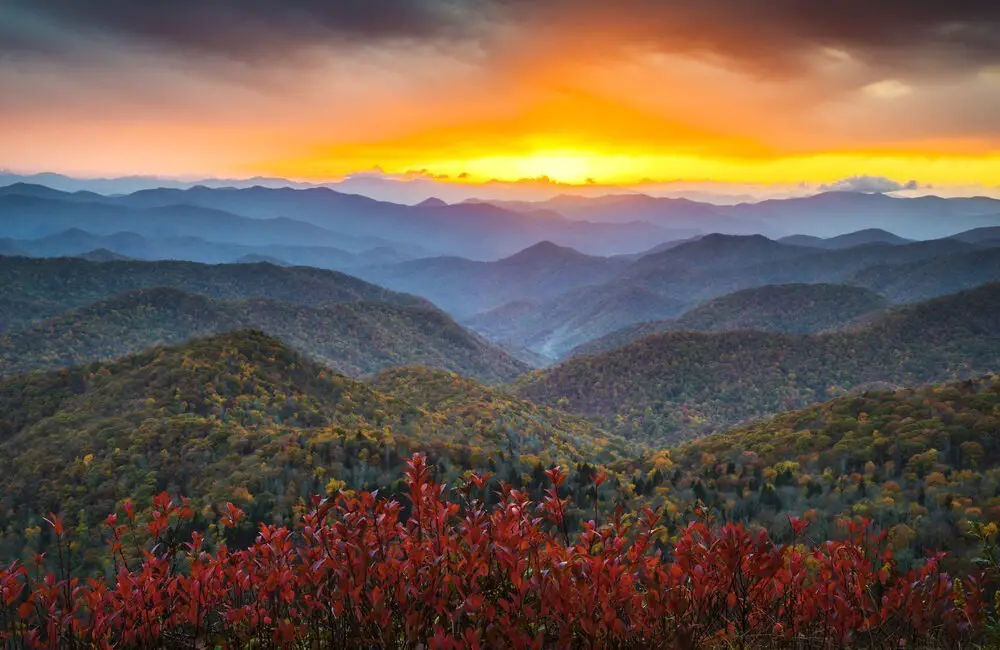
Exploring the Waterfalls of the Blue Ridge Parkway
Overview of waterfalls along the Blue Ridge Parkway
One of the most enchanting aspects of the Blue Ridge Parkway is the abundance of waterfalls that can be found along its route. These cascades provide a refreshing break from the drive and offer a serene setting for nature lovers and photographers alike.
Popular waterfalls to visit and their unique features
The Blue Ridge Parkway is home to several spectacular waterfalls, each with its own allure and unique features. Here are a few notable ones worth visiting:
- Crabtree Falls: Situated near milepost 339.5, Crabtree Falls is the highest cascading waterfall east of the Mississippi River. With a series of five major cascades, it offers a remarkable sight for visitors.
- Linville Falls: Located near milepost 316, Linville Falls is one of the most popular waterfalls along the parkway. It features various viewpoints, including an impressive overlook of the 90-foot plunge waterfall.
- Looking Glass Falls: Just off the parkway near milepost 417, Looking Glass Falls is a beautiful and accessible waterfall. Its name is derived from the reflective qualities of the water cascading over the rocks.
Hiking trails and accessibility to the waterfalls
Many of the waterfalls along the Blue Ridge Parkway are accessible via short hiking trails or roadside pull-offs. These trails vary in difficulty, ranging from easy strolls to more challenging hikes, and offer visitors the opportunity to immerse themselves in the beauty of the surrounding landscapes.
It’s important to note that while some waterfalls can be viewed from overlooks or parking areas, others require a hike to get a closer look. Visitors should come prepared with proper footwear, water, and a sense of adventure to fully enjoy the experience.
Discovering Wildlife on the Blue Ridge Parkway
Variety of wildlife species found along the Blue Ridge Parkway
The Blue Ridge Parkway is teeming with wildlife, thanks to its diverse habitats and protected forests. From elusive black bears to graceful deer and playful otters, there is an abundance of animal species to be found along the parkway.
Birdwatching opportunities and notable bird species
The parkway is a haven for birdwatchers, offering ample opportunities to spot and observe avian species. Some notable bird species that can be found in the area include:
- Peregrine Falcons: These majestic raptors are known for their impressive speed and aerial acrobatics.
- Ruby-throated Hummingbirds: One of the smallest bird species in North America, these vibrant birds can be seen darting around flower gardens along the parkway.
- Red-tailed Hawks: These birds of prey are a common sight soaring above the mountains, on the lookout for their next meal.
Tips for spotting and observing wildlife safely
To maximize your chances of spotting wildlife while also ensuring your safety and the well-being of the animals, keep the following tips in mind:
- Be patient and observant: Wildlife sightings can be unpredictable, so take your time and keep your eyes and ears open.
- Respect their space: Keep a safe distance and use binoculars or a telephoto lens to observe wildlife without disturbing their natural behavior.
- Do not feed or approach wildlife: Feeding wildlife can be harmful to both animals and humans, as it can disrupt their natural diet and behavior.
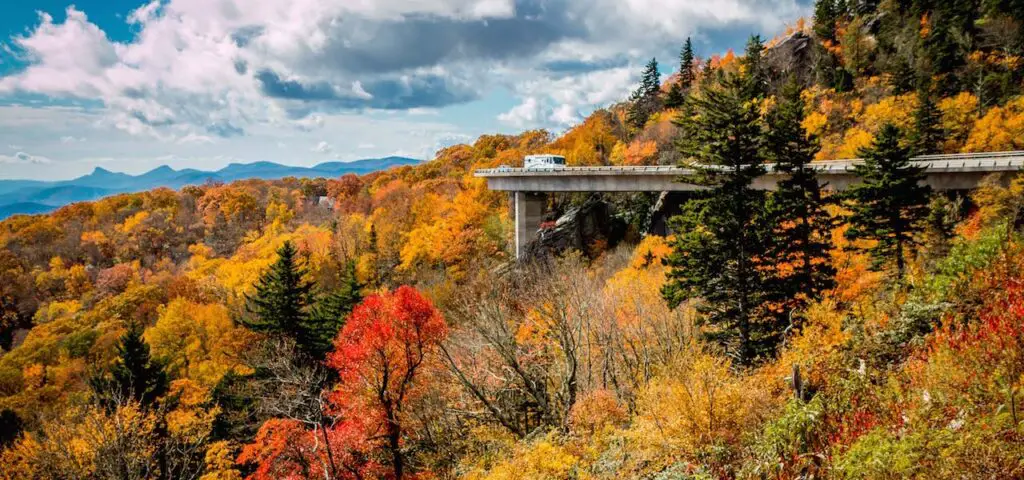
Cultural and Historical Points of Interest
Historic sites and landmarks along the Blue Ridge Parkway
Beyond its natural beauty, the Blue Ridge Parkway is dotted with significant historic sites and landmarks that provide insight into the region’s past. Some notable points of interest include:
- Humpback Rocks: Located near milepost 5.8, Humpback Rocks features a preserved 19th-century Appalachian farmstead, offering visitors a glimpse into the daily lives of early settlers.
- Moses H. Cone Memorial Park: Situated near milepost 294, this park encompasses the former estate of Moses Cone, a prominent figure in the region’s textile industry. The park includes a beautifully preserved mansion and miles of tranquil carriage trails.
- Cherokee Indian Reservation: Located near the southern end of the parkway, this reservation is home to the Eastern Band of Cherokee Indians. Here, visitors can explore the rich Native American heritage of the region.
Native American heritage and influence in the region
The Blue Ridge Mountains have a deep-rooted Native American heritage that spans thousands of years. The Cherokee and other Native American tribes have lived in the region for generations, influencing its culture, traditions, and land.
Visitors to the Blue Ridge Parkway can explore the region’s Native American heritage through various interpretive exhibits and cultural events. The Qualla Arts and Crafts Mutual, located near Great Smoky Mountains National Park, offers a chance to learn about traditional Cherokee arts and crafts and to purchase authentic Native American artwork.
Preservation efforts and cultural events
Preservation is a key aspect of the Blue Ridge Parkway’s mission. Numerous organizations and volunteers work tirelessly to protect and showcase the cultural heritage of the region. The parkway hosts a variety of cultural events throughout the year, including music festivals, craft fairs, and living history demonstrations, which provide a deeper understanding of the region’s past.
Outdoor Activities on the Blue Ridge Parkway
Hiking trails and backpacking options
For those seeking adventure and a closer connection to the natural beauty of the Blue Ridge Parkway, the park offers an extensive network of hiking trails and backpacking opportunities. These trails range in difficulty, offering everything from short, family-friendly hikes to multi-day backpacking adventures.
Some popular hiking trails along the parkway include:
- Black Balsam Knob: This trail near milepost 420 leads to panoramic views of the surrounding mountains, making it a favorite among hikers and photographers.
- Roan Mountain: Located near milepost 355, this trail offers a unique alpine experience with stunning wildflowers in the spring and sweeping views year-round.
Camping and picnicking facilities along the parkway
Camping and picnicking are popular activities along the Blue Ridge Parkway, providing an opportunity to relax and soak in the beauty of the surrounding landscapes. The parkway offers a range of campgrounds and picnic areas, each with its own unique charm.
Some campgrounds along the parkway include:
- Julian Price Memorial Park: Situated near milepost 297, this campground offers stunning lakeside campsites and a variety of recreational activities, including fishing and boating.
- Mount Pisgah Campground: Located near milepost 408, this serene campground is nestled at the base of Mount Pisgah and provides easy access to hiking trails and breathtaking views.
Fishing and water sports opportunities
For outdoor enthusiasts who enjoy fishing and water sports, the Blue Ridge Parkway has plenty to offer. The parkway is home to numerous lakes and rivers that are perfect for fishing, canoeing, kayaking, and paddleboarding.
Some popular fishing spots along the parkway include:
- James River: This river, which runs parallel to the parkway for miles, is known for its abundance of smallmouth bass and catfish.
- Doughton Park Lake: Located near milepost 240, this tranquil lake is stocked with trout and offers a peaceful setting for fishing and boating.
Visiting the Blue Ridge Parkway in Different Seasons
Springtime blooms and wildflowers
Spring is a magical time along the Blue Ridge Parkway, as the mountains burst into bloom with colorful wildflowers and lush vegetation. From delicate trilliums and lady slippers to vibrant rhododendrons and mountain laurels, the parkway comes alive with a riot of colors.
Hiking trails and meadows become a paradise for wildflower enthusiasts, offering unique opportunities to witness the beauty of nature up close. It’s a season of renewal and transformation, as the landscapes transition from the starkness of winter to the vibrancy of spring.
Summer activities and recreational options
Summer is a popular time to visit the Blue Ridge Parkway, as the warm weather opens up a plethora of recreational opportunities. Whether you’re interested in hiking, fishing, camping, or simply relaxing amidst the scenic beauty, the parkway has something for everyone.
The longer days and pleasant temperatures make it an ideal season for outdoor activities. Many visitors enjoy picnicking at one of the park’s many scenic spots, while others take advantage of the abundant trails to explore the diverse landscapes.
Fall foliage and stunning autumn landscapes
When autumn arrives, the Blue Ridge Parkway transforms into a breathtaking canvas of reds, oranges, and yellows. The stunning fall foliage draws visitors from all over the world, as the mountains are cloaked in a vibrant tapestry of colors.
The peak of fall foliage varies from year to year, but generally occurs around mid-to-late October in the higher elevations and extends into November in the lower elevations. Visitors during this time can enjoy leisurely drives along the parkway, stopping at overlooks and hiking trails to fully immerse themselves in the stunning landscapes.
Winter wonderland and seasonal closures
Winter on the Blue Ridge Parkway offers a different kind of beauty and serenity. The parkway becomes a winter wonderland, with snow-covered landscapes and frost-kissed trees. While some sections of the parkway may be closed due to inclement weather, there are still ample opportunities for outdoor activities such as snowshoeing and cross-country skiing.
Winter is also a time of tranquility and solitude, with fewer visitors and a slower pace. It’s the perfect season for those seeking a peaceful retreat amidst nature’s quiet beauty.
Exploring Local Communities and Towns
Insight into the mountain communities along the Blue Ridge Parkway
The Blue Ridge Parkway is more than just a scenic drive; it is a gateway to the colorful mountain communities and towns that dot its route. These small, charming towns offer a glimpse into the rich cultural heritage and warm Southern hospitality that is characteristic of the region.
Some notable communities along the parkway include:
- Asheville, North Carolina: Situated near the southern terminus of the parkway, Asheville is a vibrant city known for its arts scene, craft breweries, and historic architecture. It serves as a gateway to the stunning landscapes of the nearby Pisgah National Forest and the Great Smoky Mountains.
- Roanoke, Virginia: Located near the northern end of the parkway, Roanoke is a bustling city with a rich railroad history and a vibrant downtown. Visitors can explore its numerous museums, art galleries, and outdoor recreational opportunities.
Arts and crafts scene in the area
The Blue Ridge region has long been a haven for artists and craftsmen, who draw inspiration from the natural beauty that surrounds them. Visitors to the area can immerse themselves in the vibrant arts and crafts scene, with opportunities to purchase unique handcrafted goods and witness skilled artisans at work.
One such place is the Folk Art Center near Asheville, North Carolina. Operated by the Southern Highland Craft Guild, this center showcases traditional and contemporary crafts and hosts regular exhibitions and demonstrations. It’s a must-visit for anyone interested in the rich artistic heritage of the region.
Local cuisine and dining experiences
No exploration of the Blue Ridge Parkway would be complete without indulging in the local cuisine. The region is known for its farm-to-table dining experiences, showcasing the bounty of the land and the creativity of local chefs.
Visitors can savor traditional Southern specialties such as fried chicken, collard greens, and cornbread, as well as contemporary dishes that highlight the diverse flavors of the region. The area is also home to numerous wineries and breweries, where visitors can sample locally produced wines, craft beers, and spirits.
Photography Opportunities on the Blue Ridge Parkway
Tips for capturing the scenic beauty with a camera
The Blue Ridge Parkway offers countless opportunities for photographers to capture its stunning landscapes. Whether you’re a professional or an amateur, there are a few tips to keep in mind to enhance your photography experience:
- Timing is key: The soft light of sunrise and sunset can enhance the beauty of the landscapes, so try to plan your photography outings accordingly.
- Experiment with composition: Look for interesting foreground elements, leading lines, and unique perspectives to add depth and visual interest to your photos.
- Keep an eye on the weather: Dramatic weather conditions, such as fog, mist, or stormy skies, can add a sense of mood and atmosphere to your images.
Iconic photogenic spots and viewpoints
Along the Blue Ridge Parkway, there are numerous iconic spots and viewpoints that are a photographer’s dream. Here are a few not to be missed:
- Craggy Gardens: Located near milepost 364, Craggy Gardens offers breathtaking views of the surrounding mountains, particularly when the rhododendrons are in bloom.
- Linn Cove Viaduct: This engineering marvel provides photographers with a unique opportunity to capture the sweeping curves of the viaduct against the backdrop of the mountains.
- Mabry Mill: As one of the most photographed spots along the parkway, Mabry Mill offers countless opportunities for photographers to capture its rustic charm and picturesque setting.
Photography tours and workshops
For those looking to enhance their photography skills or simply learn more about the unique beauty of the Blue Ridge Parkway, photography tours and workshops are available. These guided experiences provide an opportunity to explore the parkway with seasoned photographers who can offer insights and tips for capturing the best shots.
Whether you’re a beginner or an experienced photographer, these tours and workshops offer a chance to hone your skills and capture stunning images that will forever remind you of your journey along the Blue Ridge Parkway.
Blue Ridge Parkway Events and Festivals
Annual events and festivals held along the parkway
Throughout the year, the Blue Ridge Parkway plays host to a variety of events and festivals that celebrate the region’s rich culture, music, arts, and natural beauty. These events offer visitors a chance to immerse themselves in the vibrant atmosphere of the area and interact with locals.
Some notable annual events along the parkway include:
- Blue Ridge Parkway Festival: Held in downtown Roanoke, Virginia, this festival celebrates the region’s cultural heritage with live music, food, and craft vendors.
- Folk Heritage Weekend: This event, held at the Folk Art Center near Asheville, North Carolina, showcases traditional music, dance, and craft demonstrations.
Music, arts, and cultural celebrations
Music, arts, and cultural celebrations are an integral part of the Blue Ridge Parkway experience. From bluegrass and folk music to local crafts and cultural demonstrations, these events offer visitors a chance to immerse themselves in the rich traditions and vibrant heritage of the region.
Throughout the year, various venues along the parkway host concerts, art exhibitions, and cultural performances that showcase the talent and diversity of the local community. These events provide a unique opportunity to connect with the region’s rich cultural tapestry and create lasting memories.
Planning a Trip to the Blue Ridge Parkway
Important travel information and permits required
When planning a trip to the Blue Ridge Parkway, it’s important to gather the necessary travel information and ensure you have the required permits. Here are a few key points to consider:
- Parkway closures and construction: Before setting off, check the National Park Service website or call the parkway’s visitor centers for any closures or construction updates that may affect your travel plans.
- Entrance fees and passes: While there are no entrance fees to drive the parkway, some amenities and attractions along the route may require a fee. Alternatively, you can purchase an America the Beautiful annual pass, which offers access to national parks and federal recreation areas across the United States.
Accommodation options in the surrounding area
The Blue Ridge Parkway offers a variety of accommodation options to suit every traveler’s needs and preferences. From rustic campgrounds and cozy cabins to luxurious resorts and bed and breakfasts, the area has something to offer for all types of travelers.
Some popular accommodation options near the parkway include:
- Campgrounds: There are numerous campgrounds along the parkway, ranging from primitive sites to RV-friendly campgrounds with modern amenities.
- Lodges and cabins: For those seeking a more comfortable stay, there are several lodges and cabins available near the parkway, offering modern amenities and scenic views.
- Hotels and resorts: In nearby towns and cities, there are a wide range of hotels and resorts available, ranging from budget-friendly options to luxury accommodations.
Transportation and getting around the parkway
The best way to experience the Blue Ridge Parkway is by driving it, as it allows for the freedom to explore at your own pace and stop at various points of interest along the way. Before embarking on your journey, ensure that your vehicle is in good condition and adequately fueled, as there are limited services along the parkway.
Public transportation options along the parkway are limited, so having your own vehicle or renting one is highly recommended. It is also important to note that there are no gas stations on the parkway itself, so plan your fuel stops accordingly.
Safety and Conservation on the Blue Ridge Parkway
Safety precautions and emergency services
When visiting the Blue Ridge Parkway, it’s important to prioritize safety and be prepared for any emergencies that may arise. Here are a few safety precautions to keep in mind:
- Stay on designated trails and overlooks: Venturing off-trail can lead to accidents and damage to delicate ecosystems, so always stick to designated paths and overlooks.
- Carry essential supplies: When exploring the parkway, be sure to carry essentials such as water, sunscreen, insect repellent, and a first aid kit.
- Observe wildlife from a safe distance: While wildlife sightings can be exciting, it is important to maintain a safe distance. Never approach or feed wild animals.
Emergency services are available along the Blue Ridge Parkway, but coverage may vary depending on location and time of year. Always be prepared, and have a plan in case of emergencies.
Leave No Trace principles and responsible tourism
Preserving the fragile ecosystems along the Blue Ridge Parkway is paramount to ensuring its beauty and natural resources for future generations. By adhering to the Leave No Trace principles, visitors can help protect the parkway’s natural landscapes.
Some key Leave No Trace principles include:
- Dispose of waste properly: Pack out all trash and follow park guidelines for waste disposal.
- Stay on designated trails: Straying from designated trails can cause erosion and damage to fragile ecosystems.
- Respect wildlife and vegetation: Observe wildlife from a safe distance and avoid touching or disturbing plant life.
Conservation efforts and organizations
Preserving the Blue Ridge Parkway’s natural beauty and cultural heritage is a collaborative effort involving numerous organizations, agencies, and dedicated individuals. The National Park Service plays a crucial role in the conservation and management of the parkway, working alongside local organizations and volunteers.
Visitors to the parkway can support conservation efforts by donating to the Blue Ridge Parkway Foundation or participating in volunteer programs and events. By doing so, they contribute to the continued preservation of this national treasure.
Conclusion
As I reflect on my experiences exploring the stunning landscapes of the Blue Ridge Parkway, I am filled with a sense of awe and gratitude. This iconic road offers an unparalleled journey through the mesmerizing beauty of the Blue Ridge Mountains, immersing visitors in a world of breathtaking vistas, diverse flora and fauna, and a rich cultural heritage.
From the scenic drives and waterfalls to the abundant wildlife and historic landmarks, there is something for everyone along the Blue Ridge Parkway. It is a place where nature and history converge, where tranquility and adventure coexist, and where unforgettable memories are made.
I invite you to embark on your own journey along the Blue Ridge Parkway, to witness the ever-changing beauty of the seasons, to immerse yourself in the vibrant cultures of the mountain communities, and to experience the awe-inspiring landscapes that make this place truly special.
